Abstract
OBJECTIVE: To evaluate urinary iodine excretion during the course of pregnancy and postpartum in relation to maternal and neonatal thyroid function parameters in Saudi women living in Jeddah, Kingdom of Saudi Arabia.
METHODS: A prospective longitudinal study was conducted on Saudi normal pregnant women during the course of pregnancy (N=80), at term and 6-10 weeks postpartum (N=65), during the period January 1997 through to December 2000. Maternal urinary iodine excretion was determined together with serum levels of total thyroxine, total tri-iodothyronine, free thyroxine, free tri-iodothyronine, thyrotropin, reverse tri-iodothyronine, thyroxine-binding globulin and thyroglobulin. A group of non-pregnant woman (N=200) were included for comparative purposes. Data were also analyzed for significant trends using ANOVA. Neonatal serum levels of total thyroxine, total tri-iodothyronine, free thyroxine, thyrotropin, thyroxine-binding globulin, and thyroglobulin were also measured.
RESULTS: Changes in urinary iodine excretion and in serum thyroid function parameters during the course of pregnancy, at term and postpartum have been demonstrated. Subclinical iodine deficiency was evident in 28.8% of pregnant women at term and 11.5% of women at 6-10 weeks postpartum. Serum total thyroxine and total tri-iodothyronine levels increased in the first trimester (P<0.001) and remained elevated at term (P<0.001). Serum free thyroxine levels showed a significant decrease by the 2nd trimester (P<0.001) and continued to decrease in the 3rd trimester (P<0.001). Serum free tri-iodothyronine showed continuous decrease throughout gestation. Thyrotropin levels were decreased during the first and 2nd trimesters (P<0.001) but then increased to be comparable to non-pregnant values. Serum reverse tri-iodothyronine increased during the first and 2nd trimesters (P<0.001). There was a significant increase in serum thyroxine-binding globulin and thyroglobulin levels during the course of pregnancy. A significant negative correlation between thyrotropin and human chorionic gonadotropin levels was observed throughout pregnancy (r=-0.31, P<0.001). The observed correlation was stronger (r=-0.37; P<0.001) in the first trimester as compared to that in the second (r=-0.164; P<0.001) or the third (r=-0.125; P<0.269) trimester. There was a negative correlation between maternal free thyroxine and neonatal thyrotropin (r=-0.70; P<0.001). Positive correlation was found between neonatal total thyroxine and birth weight (r=0.61; P<0.001) and maternal urinary iodine concentration (P<0.001).
CONCLUSION: The changes in urinary iodine excretion during the course of pregnancy were documented. The decrease in free thyroxine and free tri-iodothyronine and the increase in reverse tri-iodothyronine concentrations during pregnancy resemble the changes in thyroid hormones seen in non-thyroidal illness. Moreover, the changes in thyrotropin in relation to that of human chorionic gonadotropin support the view that the thyroid gland is not primarily thyrotropin driven in early pregnancy. The results suggest that a more complex control may finally regulate maternal thyroid activity; the pituitary and the chorionic systems both function in an independent way in response to possible different feedback stimuli. This could be a physiological adaptation enabling energy conservation during the high metabolic demands of pregnancy. Finally, the results of the present study point to the need of an increased iodine supply in Saudi pregnant women living in Jeddah, Kingdom of Saudi Arabia to decrease the potential consequences of low iodine intake on maternal thyroid economy.
- Copyright: © Saudi Medical Journal
This is an open-access article distributed under the terms of the Creative Commons Attribution-Noncommercial-Share Alike 3.0 Unported, which permits unrestricted use, distribution, and reproduction in any medium, provided the original work is properly cited.






